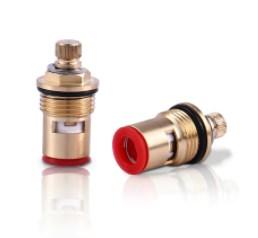Ceramic valve core is engineered to provide a high level of sealing performance, which is essential in preventing fluid leaks in various applications. The intricate design and material properties of these components contribute significantly to their effectiveness in maintaining a leak-free environment. This article explores the sealing capabilities of ceramic valve cores and the mechanisms through which they prevent leaks.
The primary function of a valve core is to control the flow of fluids within a system. To achieve this, the valve core must form a tight seal when closed, preventing any leakage. Ceramic valve cores are particularly well-suited for this task due to several inherent characteristics of ceramic materials. Firstly, ceramics are known for their excellent chemical resistance, which means they can withstand a wide range of chemicals without degrading or becoming compromised. This resistance is crucial in applications where the valve core may be exposed to corrosive or aggressive fluids.
Secondly, the hardness of ceramic materials provides a durable and wear-resistant surface. This hardness ensures that the sealing surfaces of the ceramic valve core maintain their integrity over time, even under the constant wear that can occur during repeated valve operation. The wear resistance of ceramic valve cores is further enhanced by their low coefficient of friction, which reduces the likelihood of surface damage during operation.
One of the key aspects of the sealing performance of ceramic valve cores is their design. The precision engineering involved in the manufacturing process ensures that the valve core fits snugly within the valve body, creating a tight seal. This fit is often further improved by the use of O-rings or other sealing elements, which provide an additional barrier against leaks. The design of the valve core also includes features such as tapered or conical ends, which facilitate a more secure engagement with the valve body and enhance the sealing performance.
Another factor contributing to the leak prevention capabilities of ceramic valve cores is their thermal stability. Ceramics can operate effectively over a wide temperature range without losing their structural integrity. This stability is important in applications where the valve core may be subjected to temperature fluctuations, as it ensures that the sealing performance remains consistent regardless of the operating conditions.
In addition to their material and design attributes, ceramic valve cores also benefit from the use of advanced manufacturing techniques. Modern production methods, such as computer-aided design (CAD) and computer-aided manufacturing (CAM), allow for the creation of highly accurate and consistent valve cores. This precision manufacturing ensures that each valve core is tailored to fit its specific application, further enhancing its sealing performance.
The sealing performance of ceramic valve cores is also influenced by the quality of the installation process. Proper installation is crucial to ensure that the valve core is seated correctly within the valve body, creating the necessary seal. This involves following the manufacturer's guidelines for installation, including the use of appropriate tools and techniques to avoid damage to the valve core or valve body.
In conclusion, the sealing performance of ceramic valve cores is a result of a combination of factors, including the material properties of ceramics, the precision design of the valve core, and the quality of the manufacturing and installation processes. These factors work together to provide a reliable and effective solution for preventing leaks in a wide range of applications. The use of ceramic valve cores in fluid control systems is a testament to their ability to deliver consistent and long-lasting sealing performance, making them a preferred choice for many industries and applications.



